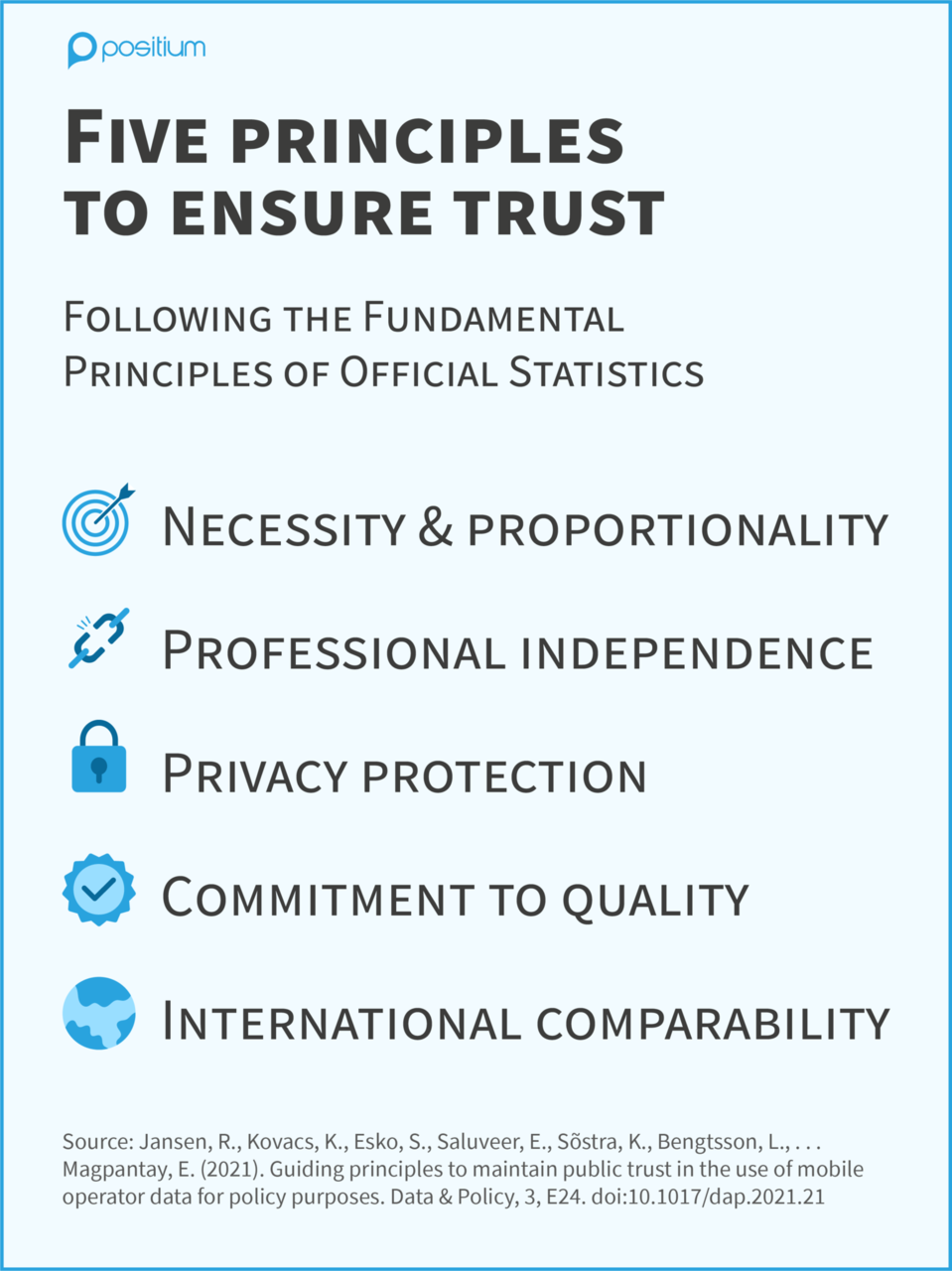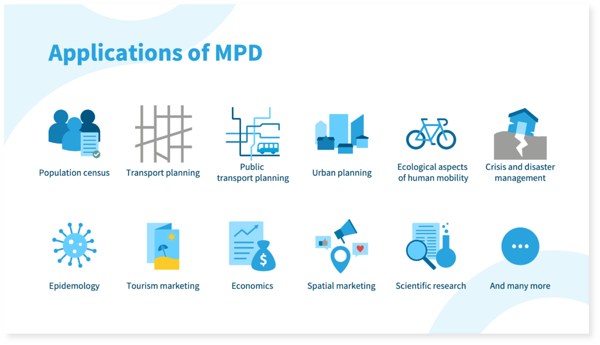1. What is mobile positioning data?
Mobile positioning data, or MPD for short, is a form of big data that is related to mobile phone usage. In Positium, we use passive mobile positioning data, which is stored automatically by all mobile network operators. Every time a call is made or an SMS is sent (call detail records or CDR) or mobile internet is used (data detail records or DDR), the metadata about this event is saved by the mobile network operator for billing purposes. This data usually includes a timestamp, pseudonymised* user id, country of origin, and id of the cell tower that the phone connected to*. MPD is not based on GPS nor satellite data.
2. How accurate is mobile positioning data?
The accuracy of passive mobile positioning depends on the coverage area of network cells. In highly populated areas where there are more towers, the accuracy can be up to a few hundred metres, while in sparsely populated places up to ca 30 km*. This means that precise locations of individuals cannot be tracked, but the accuracy is good enough to get meaningful statistical insights on a generalised level.
3. How can I be sure about privacy?
Maintaining public trust in the use of mobile positioning data is crucial*. Data security measures are in line with the General Data Protection Regulation (GDPR). Mobile positioning data does not include information about the contents of calls, SMS’ or data usage. All of the data is pseudonymised* by the mobile network operator to ensure that no personal data is given to third parties. The data is also aggregated so no individual can be traced. Positium follows high ethical standards to ensure data safety.
4. What are the benefits of mobile positioning data?
Almost everyone in the world uses a mobile phone. Mobile positioning data is collected by mobile network operators automatically for billing purposes. This means that huge amounts of MPD data already exist all over the world which can be analysed once it is available, unlike other traditional ways of gathering data for statistics, like surveys, which usually require a big investment to collect. Data from one or many mobile network operators can be used for producing statistics. The data from one operator can be generalised to the whole population*. In a sense, mobile positioning data is like a time machine – the data usually dates back many years. Unlike surveys or many other methods, MPD is continuous, not a snapshot in time, meaning you can get data about every month, day, or even hour. This offers a much more realistic view of the population and its behaviour. MPD offers a solid return on investment and provides faster results with more detailed breakdowns of countries, classes (inbound or domestic tourist, worker, transit traveller, resident, etc.), and indicators (number of homes or work time places, nights spent, etc.).
5. What are the common uses of mobile positioning data?
Mobile positioning data has a variety of use cases in different domains, such as tourism, mobility, and population studies. It can fill the gap of traditional sources, such as immigration and border surveys, with reliable information about mobility patterns and trends, not available any other way.
MPD has been used as a reliable tool to produce official statistics. Since 2008, Eesti Pank, the central bank of Estonia has been using mobile positioning data for inbound and outbound travel statistics. Since 2016, Indonesia’s Ministry of Tourism together with the statistical agency Badan Pusat Statistik (BPS) has been using MPD to release monthly cross-border tourism statistics as part of official statistics. MPD can also be used in event analytics to understand the return of investment, socio-economic and marketing impact. Examples from Positium include the 2018 Asian Games, Rally Estonia, Metallica concert, and many others.
MPD also helps to understand mobility patterns. This has a variety of use cases from urban planning to infectious disease control. The National Centre for Statistics and Information (NCSI) of Oman used MPD for tourism, population, and commuting statistics. MPD was a great help to the Estonian Government in monitoring mobility during the first waves of COVID-19. The data has also been used successfully in urban planning and building a smart city, for example as an input for developing a new bus network for the city of Tartu
Hopefully, this blog post has answered some of the questions you had about mobile positioning data. If you want to learn more about Positium and how we work with MPD and support organisations in the public and private sectors around the world, we invite you to read some of our case studies, project highlights, or the research that we have published in the field. You can also send us a message, see the details on our contact page.
*Sources:
Saluveer, E., Raun, J., Tiru, M., Laura, A., Kroon, J., Snitsarenko, T., Aasa, A., Silm, S. 2020. Methodological framework for producing national tourism statistics from mobile positioning data. Annals of Tourism Research 81, https://doi.org/10.1016/j.annals.2020.102895
Ahas, R. Aasa, A., Roose, A., Mark, Ü., Silm, S. 2008. Evaluating passive mobile positioning data for tourism surveys: An Estonian case study. Tourism Management 29(3), 469–486 https://www.sciencedirect.com/science/article/abs/pii/S0261517707001355
Anto Aasa, Pilleriine Kamenjuk, Erki Saluveer, Jan Šimbera & Janika Raun. 2021. Spatial interpolation of mobile positioning data for population statistics, Journal of Location Based Services, 15:4, 239-260, DOI: 10.1080/17489725.2021.1917710 https://www.researchgate.net/publication/351473955_Spatial_interpolation_of_mobile_positioning_data_for_population_statistics
Jansen, R., Kovacs, K., Esko, S., Saluveer, E., Sõstra, K., Bengtsson, L., Li, T., Adewole, W. A., Nester, J., Arai, A. and Magpantay, E. 2021. Guiding principles to maintain public trust in the use of mobile operator data for policy purposes,” Data & Policy, Cambridge University Press, 3, p. e24. doi:10.1017/dap.2021.21 https://www.cambridge.org/core/journals/data-and-policy/article/guiding-principles-to-maintain-public-trust-in-the-use-of-mobile-operator-data-for-policy-purposes/A4A2A8723151F901F5315279E76F651F
Aasa, A., Kamenjuk, P., Saluveer, E., Šimbera, J., & Raun, J. 2021. Spatial interpolation of mobile positioning data for population statistics, Journal of Location Based Services, DOI: 10.1080/17489725.2021.1917710 https://www.tandfonline.com/doi/full/10.1080/17489725.2021.1917710
Would you be interested in learning more about mobile big data and Positium? Let's talk about what mobile big data can do to help your organisation make decisions based on population mobility.
.png)

